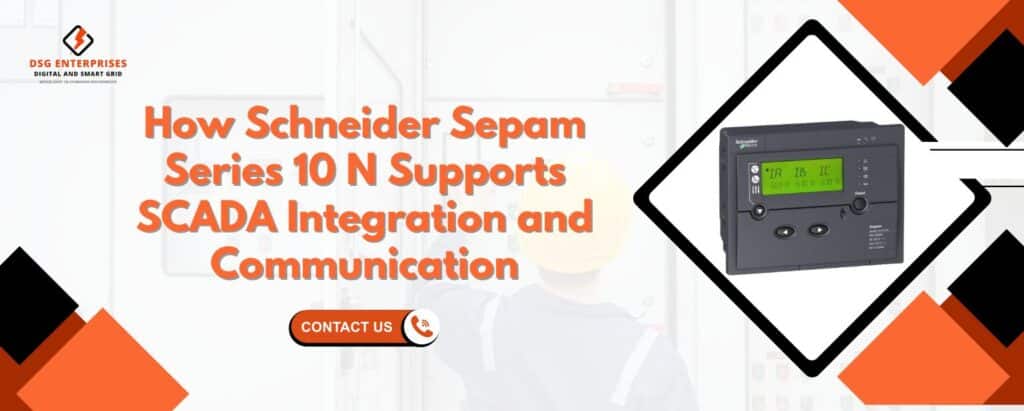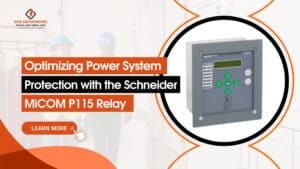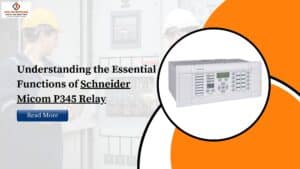In today’s rapidly evolving power distribution landscape, the need for reliable, efficient, and adaptable protection systems has never been more critical. This necessity becomes even more paramount when medium voltage (MV) networks need to be integrated into a Supervisory Control and Data Acquisition (SCADA) system. This is where the Schneider Sepam series 10N Protection Relay steps in as an ideal solution. Designed to ensure the seamless integration of secondary power distribution networks into SCADA systems, the Sepam Series 10N is renowned for its simplicity, reliability, and productivity, offering protection that’s both advanced and practical.
This blog explores how the Schneider Sepam Series 10N relay enables SCADA integration and communication, enhancing medium voltage network performance while delivering precise monitoring and control.
Overview of Schneider Sepam Series 10N for SCADA Integration
Before diving into the specific role of Schneider’s Sepam Series 10N in SCADA integration, it’s essential to understand why this integration is so vital. SCADA systems are fundamental in today’s modern power networks because they allow real-time monitoring, control, and data acquisition from remote locations.
SCADA enables centralized control over complex infrastructures such as medium voltage (MV) networks, where timely decision-making is critical to ensuring continuous operation and preventing system failures. Integrating protective devices, such as relays, into SCADA systems allows for the automated management of voltage levels, load demands, fault detections, and equipment status.
In this context, relays like the Sepam Series 10N function as crucial nodes that ensure both protection and communication within the broader SCADA infrastructure. Schneider’s Sepam Series 10N is specifically engineered to handle the challenges of modern MV networks, providing real-time data flow, event reporting, and rapid fault isolation – all vital for SCADA systems.

Seamless SCADA Integration with Schneider Sepam Series 10N
One of the strongest selling points of the Schneider Sepam Series 10N is its simplicity in terms of installation and integration. For electrical professionals, ease of installation directly impacts productivity. The quicker and simpler a device is to install and configure, the sooner the entire system can come online. With the Sepam Series 10N, Schneider has developed a relay that strikes a perfect balance between advanced functionality and user-friendly operation.
In terms of SCADA integration, this simplicity translates to effortless communication between the Sepam relay and SCADA interfaces. Schneider has equipped the Sepam Series 10N with various communication protocols, such as Modbus, IEC 61850, and DNP3, which are standard across SCADA systems. This ensures seamless data exchange, allowing the relay to send critical information about the network’s status, including alarms, event logs, and fault reports, directly to the SCADA master station.
Furthermore, the Sepam Series 10N’s straightforward parameter setup reduces the time and effort required for configuration, making it a valuable asset for engineers responsible for maintaining MV networks. Instead of navigating complex procedures, users can quickly configure communication settings for SCADA integration, ensuring faster commissioning times.
Reliability: Dependable Communication for SCADA Systems
When integrating relays into SCADA systems, reliability is key. Without consistent and dependable communication, SCADA systems cannot function effectively. This is where the Schneider Sepam Series 10N excels.
Designed with medium voltage networks in mind, the Sepam Series 10N ensures that protection and communication remain robust even in the harshest conditions. One of the relay’s main functions is to protect the network from faults and electrical failures. In addition to this core function, it provides reliable, real-time data transfer to the SCADA system, ensuring that operators always have the latest information on system performance.
For instance, if a fault is detected in an MV/MV or MV/LV substation, the Sepam Series 10N immediately sends an alert to the SCADA system. This early warning allows operators to take corrective actions, such as isolating the faulted section or rerouting power, minimizing downtime, and preventing a cascade of issues throughout the network.
The relay also offers detailed event logging, which can be communicated directly to SCADA. This ensures that all fault data is readily available for analysis, aiding in preventive maintenance and future troubleshooting. In short, the reliability of the Sepam Series 10N makes it indispensable for SCADA-integrated power systems.
Productivity: Optimizing Operations Through SCADA Communication
The Schneider Sepam Series 10N is designed to offer the essential protection functions required for MV networks. Its performance is both efficient and cost-effective, making it a popular choice for commercial buildings, shopping centers, industrial plants, and other facilities with medium voltage power supplies.
In addition to its primary protection capabilities, the relay’s SCADA integration further enhances productivity by enabling remote management and control. Through SCADA communication, operators can monitor load trends, diagnose potential issues, and control devices without having to physically inspect them on-site.
For example, in a large industrial facility with complex MV power distribution, it’s impractical to have manual checks for each substation. The Sepam Series 10N, when connected to SCADA, allows the monitoring of all key protection points from a central location. This remote accessibility ensures faster response times and improved decision-making. Operators can remotely trigger tests, reset faults, and even adjust parameters through the SCADA interface, thus significantly reducing the need for on-site intervention.
Advanced Communication Protocols
The key to successful SCADA integration lies in robust communication protocols, and the Sepam Series 10N excels in this aspect. Schneider has equipped this relay with a range of industry-standard communication options, ensuring compatibility with most SCADA systems.
- Modbus Communication: The Modbus protocol, widely used in industrial control systems, allows the Sepam Series 10N to communicate effectively with SCADA. Modbus ensures the relay can exchange data with the SCADA system, sending real-time status reports and receiving control commands.
- IEC 61850 Protocol: This protocol, designed specifically for electrical substation automation, ensures seamless communication between the Sepam relay and other substation devices within a SCADA system. With IEC 61850, the Sepam Series 10N can send data on voltage levels, fault conditions, and operational statuses, streamlining the substation’s overall protection and control.
- DNP3 (Distributed Network Protocol): DNP3 is another commonly used communication protocol that ensures reliable and efficient data exchange between the Sepam Series 10N and SCADA. DNP3 is particularly effective for long-distance communication, making it ideal for geographically dispersed MV networks.
By offering a range of communication protocols, the Sepam Series 10N ensures seamless integration into any SCADA system, enhancing the relay’s adaptability across various applications.
Protection for Secondary Power Distribution Networks
One of the primary applications of the Schneider Sepam Series 10N is the protection of secondary power distribution networks, such as medium voltage (MV/MV) or medium to low voltage (MV/LV) substations. These networks are critical for ensuring that power is safely and efficiently distributed to various end users, including office buildings, shopping centers, warehouses, and industrial facilities.
The Sepam Series 10N offers comprehensive protection functions to safeguard these networks from faults, overcurrent, earth faults, and other electrical issues. Moreover, its integration with SCADA systems allows operators to monitor the health and performance of these networks in real time. The relay provides detailed reports on network status, enabling prompt action in the event of any anomalies or faults.
For commercial buildings or industrial facilities with medium voltage power supplies, the Sepam Series 10N ensures optimal performance and minimizes the risk of power outages, equipment damage, or safety hazards.
Conclusion
The Schneider Sepam Series 10N relay is a powerful tool for SCADA integration and communication in medium voltage power systems. Its simplicity of installation and configuration, combined with reliable communication protocols and real-time data transfer, make it an ideal choice for facilities seeking to enhance their protection and control capabilities.
From providing essential protection functions to secondary power distribution networks to ensuring seamless communication with SCADA systems, the Sepam Series 10N plays a vital role in optimizing power distribution operations. With its advanced communication protocols and user-friendly setup, this relay not only delivers protection but also ensures that SCADA systems can operate effectively, providing operators with the data they need to make informed decisions.
In today’s complex power distribution environment, integrating protective devices like the Schneider Sepam Series 10N into SCADA systems is no longer a luxury—it’s a necessity. By investing in this reliable and efficient relay, facilities can ensure uninterrupted operation, enhanced safety, and optimized performance for years to come.
At Digital & Smart Grid Enterprises, we take pride in being the leading Schneider Sepam series 10N supplier and exporter of the top-tier Schneider Sepam. Our commitment is to deliver tailored relay solutions that meet various industry requirements. Whether you have questions or wish to make a purchase, feel free to contact us for Schneider Sepam series 10N Price at +917021624024 or via email at marketing@dsgenterprises.in. With our deep expertise in Sepam series 10N, we guarantee consistent support throughout your journey. Discover our extensive product range by clicking here for more information.


